|  
IN THE NEWS | GARDEN | GOOD NEWS | CALENDAR
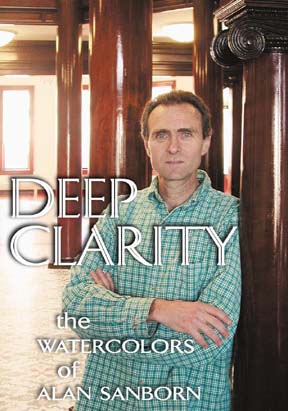
by BOB DORAN
THERE'S SOMETHING THAT DRAWS YOU INTO ALAN SANBORN'S paintings, a depth of vision that goes beyond the almost photographic attention to detail and the keen sense of light and shadow. 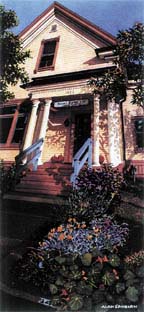 A Sanborn retrospective opened last week in the largest gallery at the Morris Graves Museum, with 26 of his watercolors on display. His landscapes often show the beauty found in unexpected places: a backyard garden, an empty lot, the remnants of an old pier on the waterfront. A Sanborn retrospective opened last week in the largest gallery at the Morris Graves Museum, with 26 of his watercolors on display. His landscapes often show the beauty found in unexpected places: a backyard garden, an empty lot, the remnants of an old pier on the waterfront.
Even if you do not frequent art galleries, chances are you've seen Sanborn's work. His paintings of gardens adorn the brochures and posters for the North Coast Growers Association Farmers' Markets. He has contributed several pieces to the public radio station, KHSU, to be reproduced as posters for pledge drives. And if you are a patient of Dr. Richard Benoit, an Arcata dentist, you get a postcard version of one of Sanborn's paintings every time you have an appointment: The reminder card bears a reproduction of a painting Sanborn exchanged for some dental work (the painting is an exterior view of Benoit's office, a historical home, shown at left). MAINE ROOTS Asked in an interview with the Journal last week why he chose watercolor as his medium, Sanborn, an upbeat 52-year-old, said he couldn't say for sure, but he suspects the seed was planted early. "I was brought up in Maine, a place with a long history of watercolorists," he said as he settled into a cozy breakfast nook in the corner of the kitchen. It's the only room in his Arcata home that doesn't have one of his paintings on the wall; instead, the cabinets are decorated with artwork by his sons, Liam, age 9, and Aidan, age 7. Sipping periodically from a steaming cup of tea, he began talking about Maine's art history and his own path to art. "John Marin, the premier watercolorist of the United States in the first half of the 20th century, did abstract landscape watercolors and he did many of his paintings in Maine. Also, Winslow Homer settled in Maine; Edward Hopper painted a lot in Maine; Andrew Wyeth lived half his life in Maine. Those things were all around me when I was growing up." 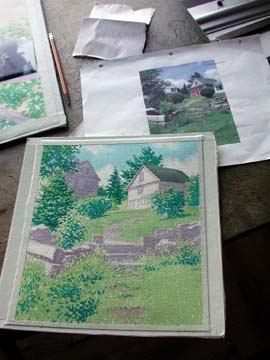 While he was in high school, the family moved to Los Angeles. When he graduated in 1968, he chose Humboldt State because it was "as far away from Los Angeles as I could get and still stay in the state school system." While he was in high school, the family moved to Los Angeles. When he graduated in 1968, he chose Humboldt State because it was "as far away from Los Angeles as I could get and still stay in the state school system."
He loved nature and the outdoors and thought he might become a forest ranger, so he enrolled as a forestry major. "It took me about a year to know that forestry didn't have much to do with being a forest ranger," he said. "I changed to oceanography. That lasted about a year, then I realized that I'd been taking science classes my whole life and I was tired of it. I switched to journalism and graduated in 1973." FINDING HIMSELF Even though he had a natural talent with a pencil -- he could always draw just about anything -- he had not studied art, not yet. That shift in focus would come later. Journalism degree in hand, he took a break from education to travel, rode across Canada on a bicycle, returned to Maine for a while, spent a year in Europe and another in Yosemite, and eventually ended up back in Humboldt. While he would not get into painting until after re-entering Humboldt State, signs pointing him in that direction popped up during his journey. He recalled a moment from his Canadian bicycle trip. "I stopped in a little museum in Banff. I was looking at paintings and saw this watercolor. It was sort of precise, a landscape with buildings. I saw the way the colors overlapped, the edges that didn't quite match up. It was beautiful. "I think that was the first time I had really looked at how a painting is put together. I realized, `Oh, it's a watercolor, that's why these things can happen.' It's not that I decided right then to paint, but it stayed with me." The notion that he might pursue painting didn't really hit him until he went to Europe. In particular, he was impressed by the dramatic Spanish artist Francisco de Goya. "When I saw Goya's paintings, I realized that there was something more to art than just representation. I knew I had to paint. When I came back here I was thinking I either wanted to be a writer or an artist." He enrolled at Humboldt State to work on an advanced degree in English, but quickly switched to art. With urging from the painter Glenn Berry he enrolled in the school's masters program. About a year into his studies he took a class from watercolor master Bob Benson. "I think Bob is one of the best watercolor painters in the country," Sanborn declared with a touch of reverence. "I don't know of anyone who uses the medium to its full extent the way he does, and he has a strong vision of landscapes. He's the only landscape painter I know who can paint a 360-degree landscape, all in one little rectangle. From working with Bob I realized that it's an endless medium. "I have to admit, I tried to paint like Bob Benson. Even well after I was selling in galleries and doing realism I still wanted to do Bob Benson paintings. That was my aim, to paint like him. Now I paint like me." Benson, who's taught art for 28 years, said Sanborn was the only student he ever had "who was exhibiting his paintings in a gallery in Los Angeles before the semester was over." Noting that Sanborn already had well-developed drawing skills, Benson said, "I was just in the right place at the right time to be a catalyst. "I really admire his love of the medium and how he's pushed it in his own individual direction," Benson added. A RELUCTANT RETROSPECTIVE At this point Sanborn has been painting professionally for almost 20 years. Having produced a steady stream of successful work, he has established relationships with several galleries across the country. Early on, he sold his work locally through Atlee and Atlee, a gallery in Eureka that closed in the early 1990s. Since then, he has not hooked up with another local gallery, in part because he sells a considerable amount of work directly to customers in studio sales at his home. So the Graves retrospective is one of the few times he has mounted a major exhibition in this area. He admitted that he doesn't particularly like "doing shows." When he was urged by friends like the painter Floyd Bettiga to submit a proposal to the Graves, he resisted. "Doing a show basically means painting hardcore for about nine months toward a particular goal -- and holding onto everything. You can't give anything to galleries or sell anything out of your house. Then the show will usually be a mixed bag because in nine months you might only do two or three really good paintings, then the rest of the show has to be whatever else you produced. "Not long after I talked to Floyd I saw someone else's show, a retrospective. I thought, `Hey, I can do that.' I realized that some of my best paintings are on walls here in Humboldt County, things I could get together without much trouble. I gathered slides of all the things I knew I could get my hands on here and narrowed it to 50 paintings." By the time the show was hung that number was cut almost in half. The 26 paintings on display are what he sees as the best of his work. Through them it becomes apparent where he finds beauty: a pile of junk against a wall is as striking as the flowers standing nearby. 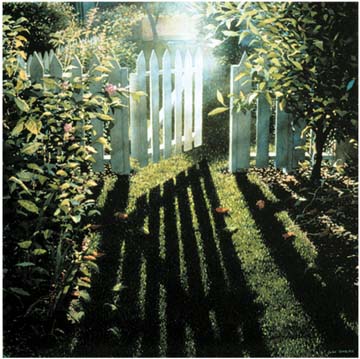 BAD PHOTOS BAD PHOTOS
Sanborn knows he can paint whatever he wants. So it comes down to what window on the world he wants to recreate with his brushes. When asked how he chooses, his initial response was vague: "When I see something I want to paint, that's what I want to paint -- period." Pressed for details, he repeated himself and then elaborated: "All I can say is I see something I want to paint: a place, a time, a light, the way light falls on things or the lack of light. I'll take a lot of photographs, sometimes they're so bad I can't find what it was I saw." It's not hard to jump to false conclusions about Sanborn's work. When you see the fine detail in his paintings and the way the shadows and light interplay, you think, `This looks like a photograph.' And you might guess that his skill is an ability to take a great photo and reproduce it using watercolors. A partially done painting on his worktable shows the error in that assumption. Several photographs are scattered across the top of the piece, simple snapshots used as reference to show him the shape of a squash leaf or what a jumble of poppies looks like. They are not great photos, not even good photos. "I could probably be a good photographer, but I'm not," he conceded. "That would take too much time and I don't own great cameras. I'd say about two-thirds of the time I work from really bad photos. I've taken pictures at noon, which is good for showing details. I just change the light and create shadows to make it afternoon." Benson agreed that Sanborn's photographs are "terrible," but said that's where the art comes in. "It forces him to come up with the content of the image on his own. People might think his work is not that creative because it's so realistic. But there are a lot of creative choices in how he develops the light, the edge quality of forms, the spaces, the shadows, the areas that are background or subordinate. That's where you'll find a lot of Alan's inventions. "If you look at the big sweep of the image, it is very impressive," Benson went on. "But I like to get up close and look at the textures of the in-between areas." INTRIGUING INTERSECTION When Sanborn selected the paintings for the retrospective, he realized that there was a through line in his work, something he called "the human landscape." The subject matter in the pieces varies from rusting trucks to beautiful gardens, from pastoral landscapes to city streets. While he often paints a world where humanity's presence is apparent, only a few of the paintings in the exhibition show people, and only a couple show an untouched landscape. What is depicted is the intersection of civilization and nature. "I rarely paint nature in a pure form; it's always been how man interacts with the landscape," he explained. "When I started I was socially or maybe philosophically involved with my painting. I was trying hard to show the human landscape -- the one we live in with all its signs and wires, markers, different shaped buildings -- somehow contrasting that with the natural landscape it's set in. [I wanted to] make some statement about the human mind and the human existence, about how muddled and cluttered our minds are -- and our lives. "I was painting the chaos of man in general, then I was finding that I was more drawn to things behind the scenes: things like trash cans behind houses. Then I was drawn more to things that showed the passage of time: waste and decay, the changing seasons. BACK TO THE LANDSCAPE "I feel like a lot of the paintings in this show honor what you might call the Humboldt school of landscape, the school of painting that has the land as its derivative," he went on. "There's a tradition of landscape painting, particularly with artists like [George] Van Hook and [Jim] McVicker. And [there are] a lot of people who moved here for the land and haven't been academically involved, Sunday painters as they call them." Since he settled here Sanborn has seen phenomenal change in the county's art scene. While Hobart Brown and his friends were turning Ferndale into an artist's colony, the art department at Humboldt State was burgeoning and a community was developing in Old Town with painters tucked away in studios above the commercial district. Organizations like the Humboldt Arts Council and the Ink People became a vital force. Amid that change came a new respect for landscape painting. "There are so many people involved in landscape painting here, people who moved here because they love the land: They love the forest, the ocean. People who were fleeing the cities in the back-to-the-land movement, and since then more have come because they are drawn to the area's physical beauty." As Humboldt's economy shifts from resource extraction to tourism, artists serve a new function. For some a picturesque vista rendered in oils or watercolors can become a political statement. "Beyond recognizing the beauty of the landscape, [landscape painters] recognize the social and political aspects of land in this time," Sanborn contended. "I feel like there's a political reality based around land use up here, and when you paint the land, there is a social/political value to it. Most landscape painters up here are aware of the often stormy political aspects of land use. "But then again, you can only get so philosophical about your paintings. If you're doing realism or representational stuff, there are times when you want to paint something simply because of the way light shines on it. You think, `This is what it's all about, painting what you like when you see the light.'" Editor Keith Easthouse contributed to this report.
In the artist's words 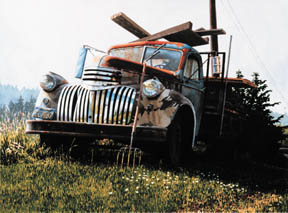 Stephen's Pick-up -- 1987 Stephen's Pick-up -- 1987
"It's a dynamic composition, but I did not set anything up. I left the pitchfork right where it was. The truck belongs to some friends, the McCollums. They own about eight acres on the Smith River where they have a big garden. "Stephen used to go up in the woods to find downed trees, and he would cut his own lumber for a lot of things. That's the load on the back. His father was a field foreman for Pacific Lumber back when it was a family owned business." "To me the truck symbolizes a time and an era of rural farming: the last generation, a time when farm work was generally done by hand, but with a couple of big machines, the pick-up truck and the tractor. Before corporate farming took over there was a generation of family farmers who worked the land with horses, then for a generation and a half, a small pick-up and a tractor were the mainstays." 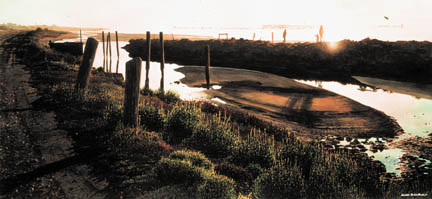 Humboldt Bay -- 1989 Humboldt Bay -- 1989
"This one shows the bay right near the Eureka Marsh. The painting is owned by Carol and Charles Ollivier. He was the president of the Longshoreman's Union and on the Harbor Commission at the time. His wife Carol grew up in Eureka and they used to take the ferry across the bay near here. "I painted it just because I used to run and walk and wander around Eureka when I lived there in the '80s. I took the picture because I just loved the way it looked with the remnants of some old structure and the old wharf that's no longer used." 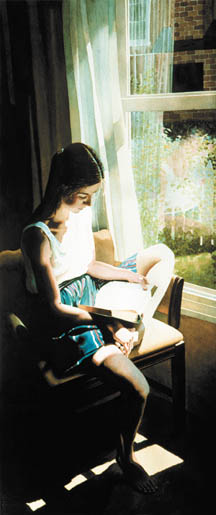 (Note the overexposed section along the horizon -- that's purely a photo effect). (Note the overexposed section along the horizon -- that's purely a photo effect).
"Sometimes I leave things the way they are in the photo. That's how they figured out that Vermeer was a photo-realist who used optics in his paintings; he would leave little effects like that in his paintings." (This painting was reproduced as a poster for a KHSU fund drive.) Lisa Reading -- 1991 "This was a birthday present for my wife, Lisa. I get her to pose every once in a while. It's easier if she's reading or doing something where she's still. I think it's successful technically and it has a good feeling. It definitely feels like Lisa; she tends to be quiet and she seeks out the warmth. I also like the way things are just suggested in the shadows. I love to take people and have them start to get lost in the background." Chris in Her Herb Garden -- 1994 "My favorite painting. I had it in a gallery once but instantly realized I did not want to sell it. I love it because it captures what I started to do philosophically. It shows the clutter of what it is to be human and at the same time puts it in a context that has a lot to do with the way we live here, where human life and nature are sustainable and live together in harmony and in chaos. 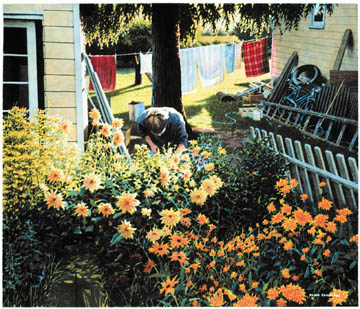 "You see today's work being done [the clothesline]; there's all the work that's not going to be done [the jumble of things against the wall]. There are things waiting to be done like the molding leaning against the building. She's in an herb garden that has been taken over by flowers, gathering herbs to make dinner. "You see today's work being done [the clothesline]; there's all the work that's not going to be done [the jumble of things against the wall]. There are things waiting to be done like the molding leaning against the building. She's in an herb garden that has been taken over by flowers, gathering herbs to make dinner.
"The composition is completely chaotic, but with a strong center: a redwood right in the middle. The redwood is a symbol of what we are. The light bounces everywhere, but it seems to have a calmness despite the chaos. It represents life: If you don't worry about everything being finished you get to enjoy it. 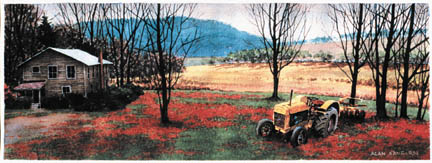 Tractor, Farm, Mountain -- 2001 Tractor, Farm, Mountain -- 2001
"This is the upper Appalachians. It's not from my own photograph. It was a National Geographic photo, a huge picture of people auctioning off farm equipment, that's what the photo was about. At the top in a thin strip it had this vista of the mountains, but not exactly. I added things, changed things. The trees weren't there, the tractor wasn't there, the house was different. "Both of my grandfathers had farms, one just had horses, one had a tractor. One of those farms was in a place like this where the White Mountains come into Maine. So this comes from my past, but it's also a comment on the abandonment of the family farm. The seasons are changing, it's rich and warm and vacant at the same time." 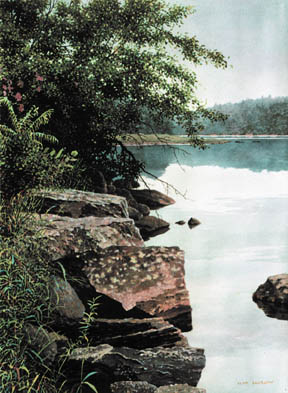 Presumpscot River -- 2003 Presumpscot River -- 2003
"This is where the Presumpscot River meets the ocean, right at the edge of Portland, Maine. It's where my father swam when he was a kid. It's where my brother and I dumped his ashes when he died. "I've done about 10 paintings from that spot so far. It was a particularly special day; there was a horrible thunderstorm that stopped right when we got there, when we went to spread his ashes. To me it's just typically Maine, a calm mundane moment at a mundane place. "If I paint for anybody, probably I paint for [my father]. He was a strong influence, even though he wasn't much like me. He was an NRA member, a lifelong Republican, Marine Corps alumni, a Mason. I couldn't be more different socially and politically. Nevertheless, I think our aesthetic was very similar. When I have a painting I'm particularly proud of, I [think] `Yep, he's going to like this one too.'" My Father's Gate -- 2000 (near top of article) "Another one about my father. This is my father's gate. He owned the house I live in. He bought it and they were going to move up here to retire, but he kept putting off retiring, so after a few years we bought the house. When he still owned it, he built this gate. Years after he built it, it still opened and closed perfectly. "I saw the way the light was shining on it one day, the way the pickets throw shadows to form a pyramid with the opening into the yard at the apex. Our yard never looked so good. I ran and got my camera. "When I painted it, it was just another painting, but now I know it's a very spiritual painting, it shows something deeper. My father and my mom opened a gate for me to go through. The pyramid shows all of the generations that got me to where I am. I think about my own kids, wondering if I will be able to honor the pyramid of those who came before me by making a gate as easy to pass through, as brilliant as this for my children to go through."
THE HUMBOLDT ARTS COUNCIL presents a retrospective exhibition of watercolor paintings by Alan Sanborn in the William Thonson Gallery, Jan. 16 through Feb. 23, 2003, at the Morris Graves Museum of Art, 636 F St., Eureka. An opening reception will be held from 6 to 9 p.m. on Feb. 1, during Arts Alive!
IN THE NEWS | GARDEN | GOOD NEWS | CALENDAR Comments? E-mail the Journal: [email protected] 
© Copyright 2003, North Coast Journal, Inc. |